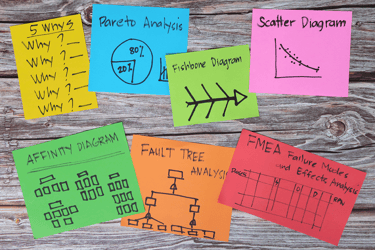The Packaging Industry's Sustainability Challenge: Why ERP Systems Are Essential for Success A straightforward guide to navigating sustainability regulations across folding carton, flexible...
Why Root Cause Analysis Is Essential for Corrugated Plant Performance
In a high-speed corrugated environment, you’re surrounded by moving targets - paper quality, heat levels, tension, speed, glue mix, splice timing.
When something goes wrong, the instinct is to act fast. Tweak a setting. Swap a roll. Add more glue.
But without understanding why the problem happened in the first place, you’re only solving it for today. Tomorrow, it comes back.
That’s where Root Cause Analysis (RCA) makes the difference between firefighting and continuous improvement. For operational teams in corrugated manufacturing, RCA isn’t a luxury - it’s a foundational discipline for uptime, consistency, and process excellence.
What Is Root Cause Analysis?
Root Cause Analysis is a structured method used to pinpoint the underlying cause of a problem, not just the immediate trigger, but the source that set it in motion.
Think of RCA as the opposite of guesswork. Instead of jumping to conclusions or trial-and-error, you follow a logical path of cause and effect.
At its core, RCA is built around this simple concept:
If we don’t fix the root cause, we’ll keep seeing the same failure, just in different forms.
In the context of a corrugated plant, this means understanding how a splice failure might be traced back to web tension misalignment, which itself may be the result of sensor drift, missed calibration, or environmental conditions.
Why Root Cause Thinking Matters in Corrugated Operations
Corrugated lines are incredibly sensitive systems. The difference between 98% board quality and 85% can hinge on one faulty valve or inconsistent pressure. RCA provides teams with the lens to zoom out and view the entire chain of cause and effect.
Here’s why it matters:
Recurring Issues Are Expensive
The same 20-minute downtime on the double-backer, if repeated weekly, adds up to a significant loss in OEE. RCA stops that cycle by solving the systemic issue, not just today’s workaround.
Surface Fixes Undermine Performance
Operators might be instructed to reduce speed to avoid jams, but the real issue could be web tracking drift, poor splice quality, or steam pressure fluctuations. Each temporary fix introduces new inefficiencies.
Process Control Needs Data-Driven Insight
You can’t automate inconsistency. RCA helps isolate variables that need tighter control - heat zones, starch viscosity, paper moisture - and feeds that insight into your control strategy.
Better Communication Across Roles
RCA encourages cross-functional input from operators, maintenance, and process engineers. The process turns tribal knowledge into shared understanding - ideal for onboarding new team members or scaling best practices across shifts or plants.
A Practical Example: Solving Warp with Root Cause Thinking
The Problem:
Operators are noticing an increase in board warp on double-wall orders, resulting in waste and customer complaints.
Typical Fix:
Slow the line, reduce stack height, or tweak heat settings. This temporarily reduces the issue, but it eventually returns.
With RCA:
The team follows a structured analysis:
-
Why is the board warping?
→ The bottom liner is shrinking more than the top.
-
Why is the bottom liner shrinking more?
→ It’s exposed to higher temperatures for longer.
-
Why is it overheating?
→ The steam pressure on the lower double-backer is too high.
-
Why is the pressure too high?
→ A failed steam trap is not regulating correctly.
-
Why did the steam trap fail?
→ PM was missed due to a gap in the maintenance schedule.
The Root Cause:
Breakdown in planned maintenance routines allowed equipment degradation to go unnoticed.
The Real Fix:
Introduce a clear Project Management (PM) checklist tied to board quality Key Performance Indicators (KPIs). Log temperature trends across shifts. Assign ownership to maintenance and shift leads to ensure accountability and responsibility.
Making RCA a Daily Habit: How to Embed It in Your Plant Culture
You don’t need a Six Sigma Black Belt to use RCA effectively. What matters is the discipline to stop, ask the right questions, and act on what you find.
Start with these steps:
- Use the 5 Whys - For any issue - warp, splice failure, jams - ask “why?” at least five times. Push past the surface.
- Build Cross-Functional Teams - Include process engineers, operators, and maintenance. Each has a piece of the puzzle.
- Document and Share - Use a shared RCA log or issue-tracking board. Make problem-solving visible.
- Tie RCA into Your Control Strategy - Feed insights back into control systems - adjust PID loops, sensor calibration windows, or alarm thresholds based on factual findings.
- Train for Thinking, Not Just Tasks - Give operators the tools and authority to question why, not just follow a fix-it script.
Closing Thoughts
In a corrugated plant, every sheet of wasted board, every extra gram of glue, every stop-start on the line has a cost. But the true cost is invisible until you take the time to find it.
Root Cause Analysis helps you do just that.
It’s not about slowing down - it’s about solving smarter. And in a competitive industry where margins are tight, uptime is king, and quality is non-negotiable, RCA is how you shift from reactive to proactive manufacturing.
The most efficient plants aren’t the ones that never have problems. They’re the ones who learn from everyone, and never let it happen twice.




